
Piero della Francesca was an Italian painter of the Early Renaissance. To contemporaries he was also known as a mathematician and geometer. Nowadays Piero della Francesca is chiefly appreciated for his art. His painting is characterized by its serene humanism, its use of geometric forms and perspective. His most famous work is the cycle of frescoes The History of the True Cross in the church of San Francesco in the Tuscan town of Arezzo.
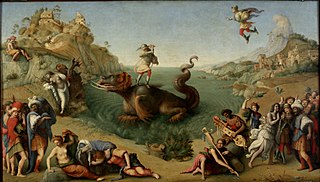
Piero di Cosimo, also known as Piero di Lorenzo, was an Italian painter of the Renaissance.
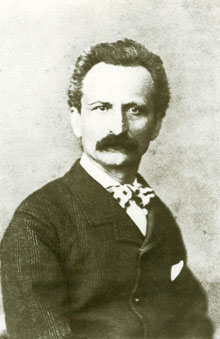
Silvestro Lega was an Italian realist painter. He was one of the leading artists of the Macchiaioli and was also involved with the Mazzini movement.
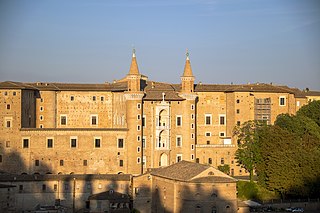
The Ducal Palace is a Renaissance building in the Italian city of Urbino in the Marche. One of the most important monuments in Italy, it is listed as UNESCO World Heritage Site since 1998.

Giovanni Santi was an Italian painter and decorator, father of Raphael. He was born in 1435 at Colbordolo in the Duchy of Urbino. He studied under Piero della Francesca and was influenced by Fiorenzo di Lorenzo. He was court painter to the Duke of Urbino and painted several altarpieces. He died in Urbino.
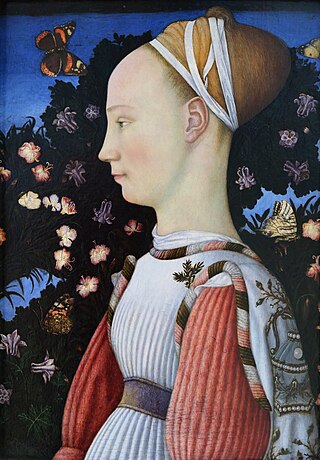
Portrait of Princess is a tempera painting on panel attributed to the Italian Late-Gothic master Pisanello. It was probably executed between 1435 and 1445 and is also known as Portrait of a Princess of the House of Este. It is firmly attributed to Pisanello on stylistic grounds and because he stayed in Ferrara in the period, where he also finished a portrait and a celebrative medal of Marquis Leonello d'Este.

Summer's Lease is a novel by Sir John Mortimer, author of the Rumpole novels, which is set predominantly in Italy. It was first published in 1988 and made into a British television mini-series, first shown in 1989. The title "Summer's Lease" is a play on a line from William Shakespeare's Sonnet 18: And summer's lease hath all too short a date. The novel involves the leasing of a Tuscan villa for the summer holidays. It is divided into six parts: "Preparations", "Arrival", "First Week", "Second Week", "Third Week", and "The Return".
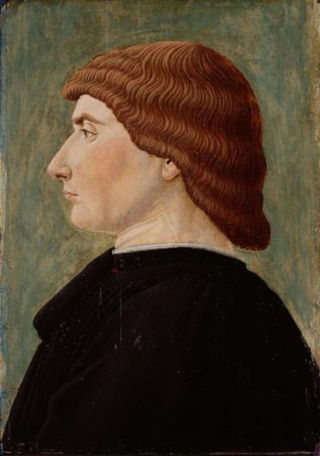
Fra Carnevale OP was an Italian painter of the Quattrocento, active mainly in Urbino. Widely regarded as one of the most enigmatic artists, there are only nine works that can be definitively attributed to Carnevale known of today. Most of these have even been contested as authentic to Carnevale at various points in history.
The decade of the 1460s in art involved some significant events.

This article about the development of themes in Italian Renaissance painting is an extension to the article Italian Renaissance painting, for which it provides additional pictures with commentary. The works encompassed are from Giotto in the early 14th century to Michelangelo's Last Judgement of the 1530s.
Caroline Mary Elam is a British art historian specializing in Florentine architecture, art and patronage in the Renaissance. She has been a senior research fellow at the Warburg Institute in the University of London since 2012.

Venus and Mars is a panel painting of about 1485 by the Italian Renaissance painter Sandro Botticelli. It shows the Roman gods Venus, goddess of love, and Mars, god of war, in an allegory of beauty and valour. The youthful and voluptuous couple recline in a forest setting, surrounded by playful baby satyrs.

The Flagellation of Christ is a painting by Piero della Francesca in the Galleria Nazionale delle Marche in Urbino, Italy. Called by one writer an "enigmatic little painting," the composition is complex and unusual, and its iconography has been the subject of widely differing theories. Kenneth Clark called The Flagellation "the greatest small painting in the world".
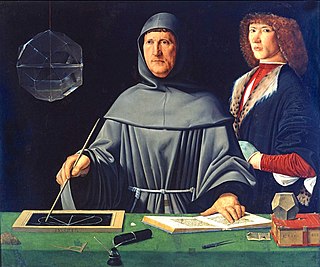
The Portrait of Luca Pacioli is a painting attributed to the Italian Renaissance artist Jacopo de' Barbari, dating to around 1500 and housed in the Capodimonte Museum, Naples, southern Italy. The painting portrays the Renaissance mathematician Luca Pacioli and may have been painted by his collaborator Leonardo da Vinci. The person on the right has not been identified conclusively, but could be the German painter Albrecht Dürer, whom Barbari met between 1495 and 1500.
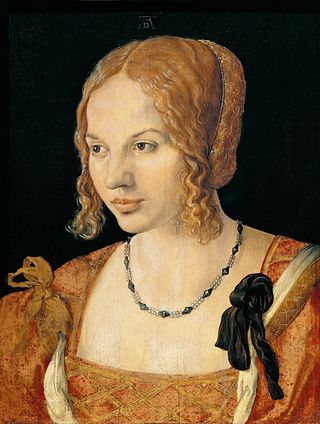
Portrait of a Young Venetian Woman is a small bust-length oil on elm panel painting by the German artist Albrecht Dürer from 1505. It was executed, along with a number of other high-society portraits, during his second visit to Italy.
The Ideal City is the title given to three strikingly similar Italian Renaissance paintings of unresolved attribution. Being kept at three different places they are most commonly referred to by their location: The Ideal city of Urbino, Baltimore, and Berlin. Hubert Damisch, who has written at length about the paintings, refers to them as the "Urbino perspectives" or "panels". The three paintings are dated to the late 15th century and most probably they have different authors but various attributions have been advanced for each without any consensus. There is also a discussion about the purpose of the paintings as they are all in an unusual elongated format. In 2012 the Baltimore and Urbino panels were shown at a joint exhibition, with the Berlin painting being represented by a copy, as the original is too fragile to be shipped abroad.

Profile Portrait of a Young Lady is a 1465 half-length portrait, made with oil-based paint and tempera on a poplar panel, usually attributed to Antonio del Pollaiuolo, although the owning museum, the Gemäldegalerie in Berlin, now describes this work as by his brother Piero del Pollaiuolo, and as one of its most famous paintings, and as one of the most famous portraits of women from the early Italian Renaissance.

The Diptych of Federico da Montefeltro and Battista Sforza are two oil paintings by Italian artist Piero della Francesca, dated to 1473–1475. This famed double portrait is often mistitled The Duke and Duchess of Urbino—as it appears on the website of the Uffizi Gallery, which owns it. Since Battista Sforza died in 1472 and Federico da Montefeltro was not made duke until 1474, however, Battista never attained the title of duchess.

Portrait of a Young Woman is a mixed-technique painting on panel of c. 1470–1472, variously attributed to Piero del Pollaiuolo or his brother Antonio. It is now in Milan in the Museo Poldi Pezzoli, which uses the painting as its symbol.
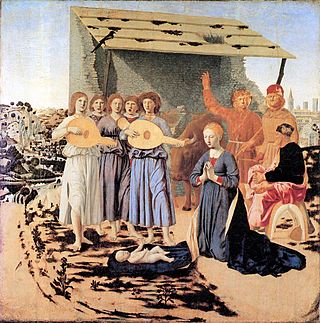
The Nativity is an oil painting by Italian Renaissance artist Piero della Francesca, dated to 1470–75. The painting depicts a scene from the birth of Jesus, and is one of the latest surviving paintings made by the artist before his death in 1492. Held by the National Gallery in London, it measures 124.4 cm × 122.6 cm. It is a popular image on Christmas cards.




















